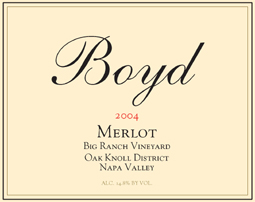

Boyd Family Vineyard
2004 Merlot, Big Ranch Vineyard(Oak Knoll District of Napa Valley)
This is how precise things are getting: Not only was the Merlot for this vintage from Boyd’s home vineyard picked from Block C, but they were harvested exactly from the 10 vines at the end of each row.
I guess that’s a good thing, because there’s lots of fresh, luscious, bright red fruit in this wine, with a hint of clove, cinnamon and some dried herbs in the finish. Furthermore, things are in check here, just this side of going over the precipice to going over the other side to being over-the-top. That’s another good thing. The tannins are soft for the short haul, however, perhaps for about a half-dozen years.
The wine was aged for 20 months in French oak, 70 percent of which was new, with the remainder being 1-year-old barrels. The listed alcohol is 14.8 percent and there were but 149 cases made. Note: Parts of Napa Valley’s Oak Knoll District, with its in-between climate of not being too hot, nor being too cold, is proving to be a good spot for growing Merlot.
Reviewed August 1, 2007 by Alan Goldfarb.
Other reviewed wines from Boyd Family Vineyard
|
Boyd Family Vineyard 2005 Syrah, Big Ranch Vineyard (Oak Knoll District of Napa Valley)Catherine Fallis 7/18/2007 |
The Wine
Winery: Boyd Family Vineyard |
The Reviewer Alan Goldfarb
Alan Goldfarb
Alan Goldfarb has been writing about and reviewing wine for 17 years. His reviews have been published in the St. Helena Star, San Jose Mercury, San Francisco Examiner, Decanter, and Wine Enthusiast, among others. Not once has he used a point system, star system, or an iconic symbol to quantify a wine. What counts in Mr. Goldfarb’s criteria when judging a wine is: how it tastes in the glass; is it well-constructed; its food compatibility; and presence of redeeming regional attributes. |












